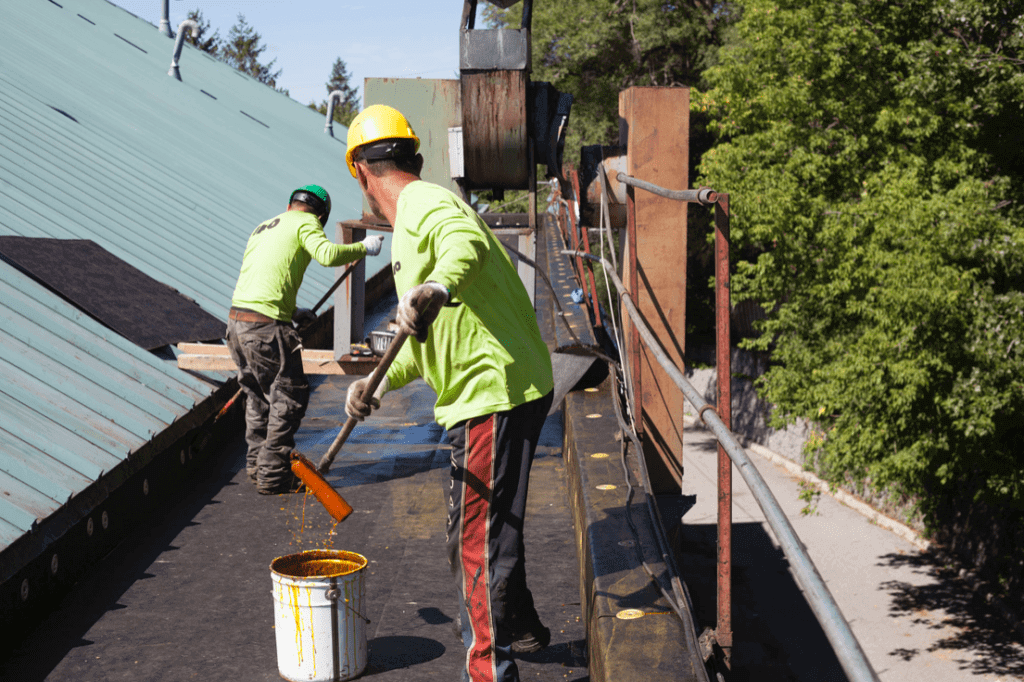Commercial roofers frequently have to perform extensive work on occupied buildings. When you’re completing a lengthy roof replacement project, you likely can’t schedule the work for a time when the building will be empty 24/7. This means tenants will be on-site while you work.
Most building owners and tenants understand that roofing is essential and that the work may cause some disturbances. If you prove you will do everything you can to make the reroofing process less impactful on the tenants, the building owner will likely invite you back for roof repairs or ask you to reroof additional buildings in their portfolio.
Gaining a reputation as a respectful roofing company may mean more business, as property managers and tenants spread the word of your good work. Here are some ways to make your roofing project much less distracting to tenants.
1. Explain the Reroofing Process

Most people don’t understand the level of detail involved in a commercial reroofing project, and that misunderstanding can lead to confusion. Tenants don’t need to comprehend the specifics of what you’re doing. However, they will want to know how the roof replacement will affect them, their customers and their daily routine. To satisfy their concerns, provide answers to a few key questions, including:
- How long might the reroofing project take?
- When will the process begin and end?
- What kind of noise, smells or debris should we expect?
- From where will you access the roof?
- Will any of your equipment take up space on the premises?
- Will the parking lot be accessible or restricted?
- Will there be areas inside the building that won’t be accessible?
- Will there be areas inside the building that get extra dirty or dusty as a result of the roofing work?
- Will the HVAC system have to be turned off? If so, for how long and on what days/times?
As a roofing contractor, you will be communicating with the owner or with the property managers, who will be conveying the information to their tenants, as absent written permission from the owner to communicate directly with the tenants, you should not directly communicate with tenants.
Ask the owner to put up signs throughout the building explaining when work will begin.
For office buildings, apartment buildings, schools, churches and other buildings with regular occupants, the owner or property manager should forward an email or written notice to the tenants to explain your work.
For stores or other buildings with unpredictable traffic, you should ask the owner or property manager to put up adequate signage that people can see as they enter the building. If a tenant or building manager approaches you with questions, use active listening techniques to hear their concerns.
2. Consider Parking and Traffic
It may seem like a small thing, but if you’ve blocked someone’s parking spot, it could ruin their day. If possible, ensure that building tenants will have access to the parking lot while you work. Try to deliver all roofing materials at once, unloading directly to the roof if possible. This ensures you’re taking as little space in the parking lot as possible, for the shortest time possible.

If you must store material or equipment in the parking lot, such as a dumpster, boom truck or other machinery, designate an area for it and mark it off with tape. Choose an area in consultation with the owner or property manager. Ideally, it will be a location that isn’t unsettling to the tenants. For example, not in front of an exit or entrance, especially a fire exit.
To avoid taking up space in the parking lot, you may be tempted to store your materials on the lawn or landscaping. However, that may cause long-term damage to the grass and should be avoided unless the owner specifically permits it.
You can also reduce your presence in the parking lot by asking your employees to carpool to work or park in a nearby parking lot. If the building has designated parking spaces or is usually full, this is a particularly good idea. That way, building tenants won’t be inconvenienced by having to walk further than normal.
3. Allow for Building Access
You want to reduce your presence in the building so that the tenants can go about their day. This means roofers should avoid using building stairwells and main elevators whenever possible. If a dedicated service elevator isn’t available, use a hydraulic lift to raise materials to the rooftop.
You should also try to perform the roof replacement outside of normal business hours. Certain businesses may have special peak hours that you should avoid. Asking the building owner about their peak hours also can make a good impression.
Here are some examples of common business hours and how you might work around them:
- Restaurants and bars: Try to finish before their lunch rush or take breaks during their lunch rush.
- Churches and religious buildings: You won’t be able to work on religious buildings during service hours or religious holidays.
- Schools: Try to schedule work for weekends, after school or during the summer holidays and breaks.
- Retail: Avoid roofing near Christmas or other peak seasons.
- Apartments and other residential buildings: Try to end work before people start coming home after 5 p.m. It’s even more important to wait to start work until people are awake.
- Hospitals, nursing homes, gyms and grocery stores: Though these businesses may operate 24/7, they still have peak hours you can avoid. Just ask the building manager or owner. Also, hospitals typically require the use of low VOC roofing materials that do not involve torches or hot asphalt.
4. Reduce Noise
A certain amount of noise is unavoidable during the roofing process. Loud noises are especially disruptive for those who are trying to work or rest. Making too much noise may drive away customers in the building, which irritates property managers.
Here are several ways you can reduce your noise:
- Install materials that require less hammering or the use of noisy equipment.
- Ask your roofers not to yell to coworkers. Instead, have them walk over to other colleagues or use their mobile device when they need to communicate.
- Ask roofers not to play loud music on the job site.
5. Account for Fumes, Odor and Dust
While rarely harmful, roofing materials that create fumes or odors can be bothersome to tenants. Some tenants are particularly sensitive to smells, and most will wonder if the odor is harmful. Such situations should be minimized where possible.
However, if your installation creates fumes or dust, make sure the owner or property manager has warned tenants that they may experience an unusual odor. Provide building owners with the latest information on the health and safety issues surrounding any products you use. Show the building owner any special precautions you are taking to prevent tenants from exposure to the fumes.
To reduce the impact of odors and fumes on occupants, you should:
- Place roofing kettles downwind of the building.
- Keep roofing kettle temperature as low as possible, to avoid generating excess fumes.
- Keep the lid on the kettle whenever possible.
- Close air intakes or windows that are downwind from roofing kettles or other fume sources.
- Shut off HVAC system to limit the spread of fumes.
6. Address Other Safety Concerns

Building tenants may not be familiar with any safety protocols. Make sure the owner or property manager has warned them about safety issues, even those that seem routine to you. For example, during the tear-off process, there may be falling debris, especially around the dumpster. You wouldn’t want to compromise the safety of people outside of the building.

Make sure the owner or property manager has notified tenants that they will need to stay clear of this area until you finish the tear-off process. When you have finished, let them know.
Warning tenants about potential safety issues without causing undue alarm can be challenging. While warning tenants about every single safety detail may make the work seem more dangerous than it is, it is better to err on the side of caution, and to encourage the owner or property manager to provide the tenants with the appropriate warnings.
If you believe that the owner or property manager is not providing the tenants with the necessary notices, and you are unable to convince them to provide the notices that you believe are advisable, you should consult with local legal counsel prior to proceeding with the work.
If the building has health and safety officers, you should meet with the officers to explain any relevant safety protocol. This is also an opportunity to hear and address any concerns the officers may want to bring to your attention.
7. Meet Your Deadlines
Setting and meeting project timelines are two key ways to reduce your disruption to property managers and tenants. Following a reasonable timeline will help reduce your impact on tenants and instill faith in the process you’ve outlined. Here are some tips on how to best set and meet your timeline for commercial roof replacement:

- Inspect the roof thoroughly before construction: The unexpected always throws a wrench into a roofing job. Cut down on surprises by ensuring that you’ve examined the roof thoroughly, accounted for every roof feature and anticipated any roadblocks.
- Set realistic timelines: If you underestimate your timeline, you’ll end up frustrating tenants when the work takes longer than expected, especially since you can’t control severe weather conditions. Finishing when you said you would is more impressive than quoting a short timeline up front.
- Ensure you have enough employees on the job: Having an adequate workforce on the job will help you meet deadlines. Make sure that you cultivate a workplace environment where employees are expected to show up on time. When workers call in sick or are injured, be sure to have additional contractors you can call in.
- Consider subcontracting: If you find yourself short on hands, you can contract out some of your work to stay on schedule so long as your agreement with the owner does not prohibit subcontracting. You may make less money in the short term, but you’ll maintain your reputation and ensure you have more work in the long term.
- Plan for inspections: If you are required to have the roof inspected by regulatory bodies, officials or building managers at any point in the reroofing process, schedule their visit so that you won’t interrupt your work while you wait for them.
- Plan for efficiency: As you gain experience with a specific type of job or roof, you’ll find that there are more efficient ways of getting the job done. If you’re always looking for these opportunities, you can save time. For example, during one commercial roof replacement, a roofing company found a way to save time by keeping most of the gravel on the roof and only moving it once. Smart thinking can save you a lot of time.
8. Clean up After the Reroof is Complete
Once your reroofing project is complete, you may be in a rush to wrap up the job. However, it’s important to ensure that you’ve cleaned up well, not only to make a good impression, but also to be sure the tenant can access the building as before.
Here’s a checklist you should look over before you leave the job site:
- Clean all debris, especially from walkways.
- Remove all equipment and materials.
- Check that roof access has been restored.
- Check that any areas where you stored equipment are now clear, including stairwells, elevators and parking lots.
- Remove any signs about the roofing work.
- Remove any warning tape.
- Remove any garden and plant protection you installed.
- Replant grass in areas where stored materials may have killed it, weather permitting.
If you’ve considered the tenant’s needs at every step of the reroofing process, you can minimize not only the tenant’s concerns during the project, but also their complaints and calls afterward. Most property managers and tenants know that your work will improve their building for years to come. When you communicate openly and do what you can to minimize the distraction a reroof causes, you’ll also earn a great reputation.
IKO has more valuable information about commercial roofing, including advice on how to prioritize your workload and information on the latest commercial roofing products. If you’re looking for an IKO distributor for your next reroofing project, use our Distributor Locator Tool.

